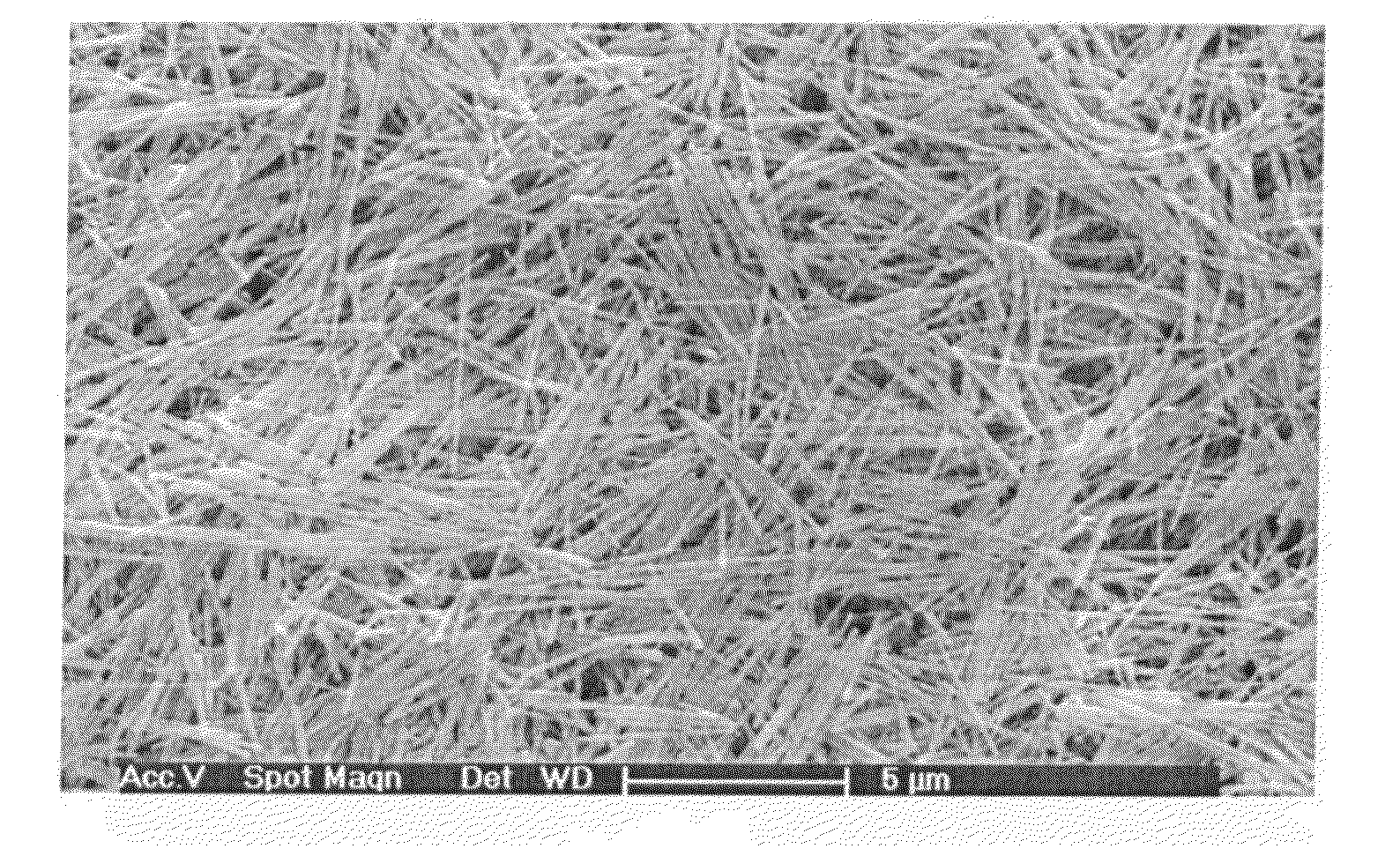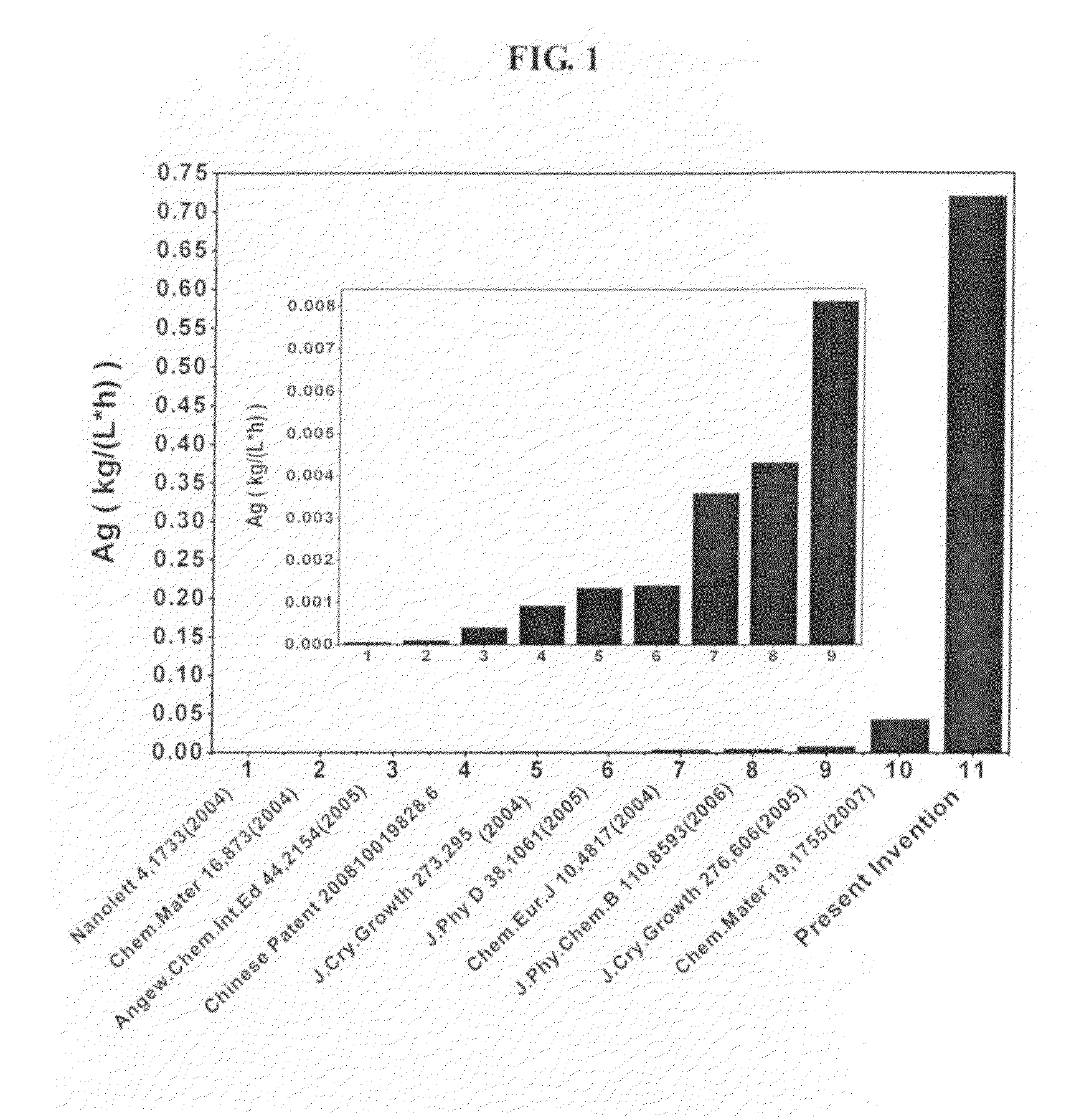Particulate nanoparticles and nanowires of silver and method for large scale producing the same
a nanoparticle and silver technology, applied in the direction of crystal growth process, polycrystalline material growth, conductor, etc., can solve the problems of carbon nanotubes as substrates, silver nanowires obtained by template-assisted methods are always impure, and the properties of adhesives are dramatically degraded, etc., to achieve good dispersibility, low filling concentration, and high conductivity
- Summary
- Abstract
- Description
- Claims
- Application Information
AI Technical Summary
Benefits of technology
Problems solved by technology
Method used
Image
Examples
example 1
[0052]2 g silver nitrate and 1.5 g polyvinyl pyrrolidone (PVP) were dissolved into 20 ml glycol under strong stirring to form a transparent aqueous solution. To the aqueous silver-PVP-glycol complex solution, 0.02 g sodium chloride (NaCl) was added and uniformly yellow-white precursor suspension was formed after a short period of ultrasonic treatment. Immediately thereafter, the prepared precursor was transferred to a microwave oven, treated with microwave irradiation at condition of 240 W 8 min. Then the silver slurry thus obtained was washed with water, centrifugaled to remove unnecessary solvent and dried to obtain a silver powder. The powder was pure silver nanowires with mean diameter of 210 nm and length of 10 μm by statistically analysis of SEM image.
example 2
[0053]2 g silver nitrate and 1.5 g polyvinyl pyrrolidone (PVP) were dissolved into 20 ml glycol under strong stirring to form a transparent aqueous solution. To the aqueous silver-PVP-glycol complex solution without sodium chloride (NaCl) addition was transferred to a microwave oven, treated with microwave irradiation at condition of 240 W 6 min. Then the silver slurry thus obtained was washed with water, centrifugaled to remove unnecessary solvent and dried to obtain a silver powder. The powder was pure silver nanoparticles with mean diameter of 100 nm by statistically analysis of SEM image.
example 3
[0054]2 g silver nitrate and 05 g polyvinyl pyrrolidone (PVP) were dissolved into 20 ml glycerol under strong stirring to form a transparent aqueous solution. To the aqueous silver-PVP-glycerol complex solution, 0.025 g potassium chloride (KCl) was added and uniformly yellow-white precursor suspension was formed after a short period of ultrasonic treatment. Immediately thereafter, the prepared precursor was transferred to a microwave oven, treated with microwave irradiation at condition of 400 W for 5 min. Then the silver slurry thus obtained was washed with water, centrifugaled to remove unnecessary solvent and dried to obtain a silver powder. The powder was pure silver nanoparticle.
PUM
| Property | Measurement | Unit |
|---|---|---|
| Fraction | aaaaa | aaaaa |
| Fraction | aaaaa | aaaaa |
| Power | aaaaa | aaaaa |
Abstract
Description
Claims
Application Information
 Login to View More
Login to View More - R&D
- Intellectual Property
- Life Sciences
- Materials
- Tech Scout
- Unparalleled Data Quality
- Higher Quality Content
- 60% Fewer Hallucinations
Browse by: Latest US Patents, China's latest patents, Technical Efficacy Thesaurus, Application Domain, Technology Topic, Popular Technical Reports.
© 2025 PatSnap. All rights reserved.Legal|Privacy policy|Modern Slavery Act Transparency Statement|Sitemap|About US| Contact US: help@patsnap.com



